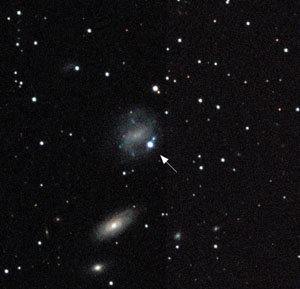An exceptionally powerful explosion in a nearby galaxy has led astronomers to re-examine their theories of stellar evolution. What is more,
the explosion was co-incident with a burst of gamma rays,
providing another clue to the origin of these bizarre phenomena.

As a large star reaches the end of its lifetime and runs out of nuclear fuel,
it becomes unstable. The core collapses inwards forming an extremely dense neutron star or black hole and sending out a shockwave which blasts the rest of the star out into space. For a few weeks,
this supernova explosion can be as bright as 100 billion ordinary stars.
Now,
a supernova has been seen that is 30 times more powerful than any measured before. Moreover,
it is coincident with a gamma ray burst. Trying to explain their observations,
astronomers suggest the existence of “hypernovae.” These are extremely massive stars that collapse into black holes and send out a very strong shockwave capable of generating the observed gamma rays.
Gamma-ray bursts have remained a mystery for 30 years. Last year,
optical and radio observations linked them to galaxies at enormous distances. These new results are important because they connect a gamma-ray burst to an explosion much nearer to home.
The gamma rays were detected by the ItalianDutch BeppoSAX satellite and optical observations were made using the European Southern Observatories telescopes in La Silla. The supernova was also observed by the Australian compact array radio telescopes.





